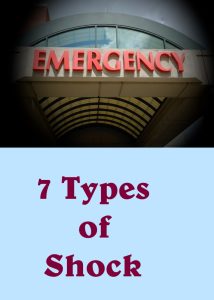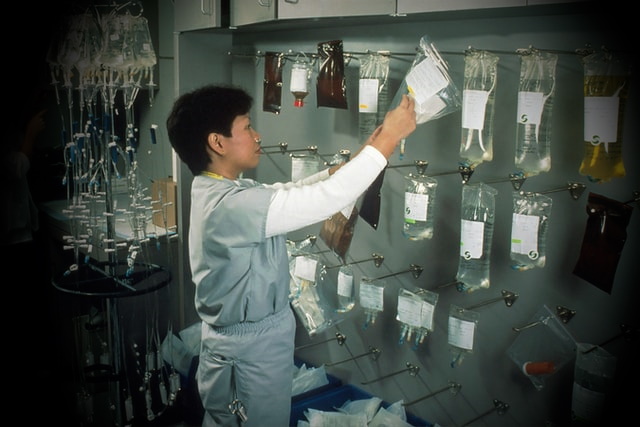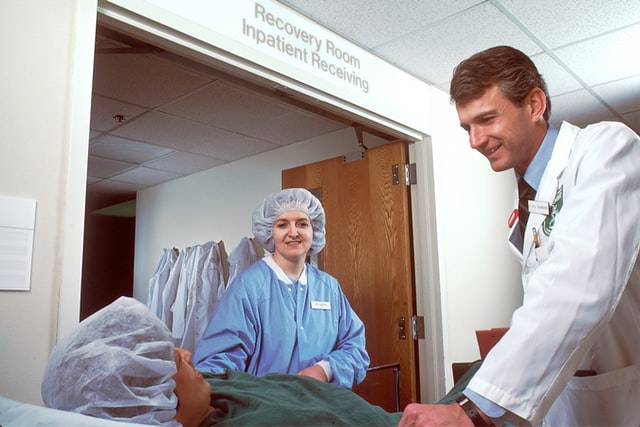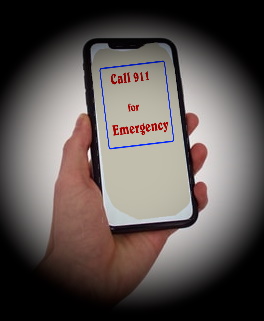
Emergency treatment by qualified medical professionals begins once a Good Samaritan calls for help, and the ambulance arrives. The whole medical team has a short window of a few hours to help a victim recover, and survive when a loved one is in one of 7 types of shock.
Shock occurs when the body goes into circulatory failure from damage, and inability to control, or loss from, circulating fluid throughout the body. A dangerous level reached in the reduction of blood flow and delivery of oxygen, to tissues and organs left untreated can lead to collapse, coma, and death.
Tests, blood and lab results and medical alert bracelet or card plus access to their primary doctors’ file on victim is needed to verify the health conditions, and any other underlying health issues before a treatment regimen can begin. Not all victims are so lucky, and do die.
Shock is applied as a ‘catch-all’ phrase since it does not fully define any one set of symptoms. There are seven types of shock and each have differing symptoms but do have a common ‘classic‘ symptom.
7 Types of Shock
Medical research has been able to identify and list the different types of circulatory shock, as follows;
Low volume shock – aka hypovolemic or hemorrhagic shock and occurs when there is low blood flow to skin and muscles from a severe loss of blood, fluid or plasma, and doesn’t fill the circulatory system.
- Causes – open wounds to the body and internal organs, loss of plasma from burns, fluid loss from gastroenteritis, vomiting
- Symptoms – dramatic blood pressure drop, weakness, confusion, pallor, sweating as the body tries to compensate
- Treatment – saline solution and plasma help replace fluids lost, severe blood loss may require a blood transfusion, close any open wounds with sutures, tests such as a CT scan will find any internal bleeding, bleeding in the skull may cause compression of the brain, a hole will need to be drilled to relieve pressure, clamps are used for bleeding from small blood vessels until able to tie them off or use of diathermy, a high frequency electric current.
Neurogenic shock – usually caused by psychological factors and overwhelms the normal bodily functions of the nervous system.
- Causes – great trauma, pain, fright, war, crime
- Symptoms – low blood pressure, dizziness, nausea, vomiting, catatonic (blank stare), fainting, increased sweating, anxiety, pale skin, and severe shock will show, difficulty breathing, chest pain, weakness, slow heart rhythm (bradycardia), weak pulse, bluish hue skin color or discolored lips and fingers aka cyanosis, hypothermia, will shiver and feel cold
- Treatment – raising the feet above the level of the head is usually enough to relieve this type of shock
Septic shock – due to a bacterial infection since some organisms multiply in the bloodstream and release toxins which reacts with blood vessels.
- Causes – injury site becomes infected and spreads into the bloodstream.
- Symptoms – high fever, chills, rapid breathing, headache, low to high levels delirium, possible skin rash, yellowish hue to the skin, warm hands. Large amounts of infection in the blood leads to septic shock.
- Treatment – several treatment strategies are used such as balanced corticosteroid usage, antiendotoxin treatment, vasoactive agents (levosimendan), hyperbaric oxygen treatment, fibrates, and several antioxidant supplements

Allergic shock – aka anaphylactic shock (anaphylaxis) is a severe reaction and high sensitivity to an injected foreign protein that directly affects blood vessels and other body tissues.
- Causes – insect venom, injection of antibiotic or other medication and/or food.
- Symptoms – itchy raised rash, swollen (constricted) airways (bronchospasm), abdominal pain, swollen tongue or throat, and diarrhea.
- Treatment – Epipen uses single epinephrine dose, severe shock requires oxygen therapy; intubation to help with breathing, medications via IV line fed, to ; reduce respiratory swelling, antihistamines, narrow blood vessels and raise blood pressure if dangerously low, help block allergic reactions and reduce swelling, low blood pressure
Cardiogenic shock – conditions or events that cause the heart to a decrease in cardiac output (weakened pumping and, or irregular rhythmic action).
- Causes – heart attack, inflammation aka myocarditis, severe heart failure, or interference to heart electrical rhythm, pulmonary embolism blocking blood flow to the heart, inflammation of abdominal cavity aka peritonitis, some types of poisoning, spinal injury, street drugs.
- Symptoms – rapid breathing, severe shortness of breath, sudden rapid heartbeat (tachycardia), loss of consciousness, weak pulse, low blood pressure (hypotension), cool moist skin, decreasing alertness, low to no urinating at all
- Treatment – treatment will focus on reducing damage from lack of oxygen to your heart muscle and other organs, oxygen therapy, IV line will feed fluids and plasma plus medications to reduce ; blood clots, low blood pressure (hypotension), improve pumping function of heart, prevent blood clots and help blood flow, and to prevent formation of blood clots. Surgery may be needed as next step.
Toxic Shock Syndrome, TSS – caused by toxins released by an overgrowth of the bacterium staphylococcus aureus, Streptococcus pyogenes, or Clostridium sordellii within the body.
- Causes – affects menstruating women, sometimes men. It’s due to infection and overgrowth of staphylococcus aureus, Streptococcus pyogenes, or Clostridium sordellii bacteria on tampons, internal birth control devices, miscarriage, surgical wounds, abortion, or an open wound. It can recur.
- Symptoms – a sudden high fever, low blood pressure, vomiting or diarrhea, a rash that looks like sunburn and sheds in sheets, particularly on your palms and soles, confusion, muscle aches, redness of eyes, mouth and throat, possible seizures, and headaches
- Treatment – IV line fed antibiotics, fluids and/or blood transfusion, heart medications for very low blood pressure, dialysis may be required in people if there is kidney failure, supplemental or mechanical oxygen, deep surgical cleaning of an infected wound
Insulin Shock – aka as #Diabetic shock, occurs when the blood sugar levels dip too low and there’s too much insulin.
- Causes – skip a meal, changing schedule of taking your insulin, changing amount or timing of meals, increasing physical activity, drinking alcohol on an empty stomach
- Symptoms – anxiety, irritability, headache, extreme hunger, dizziness, physical shaking of extremities, pale skin, excessive sweating, slurred speech, confusion, rapid pulse, coordination issues, seizures, fainting, coma plus additional symptoms of nightmares, calling out while sleeping, aggressive behaviour, sweat-soaked clothing or bedding
- Treatment – a conscious victim can take a fast-action sugar candy or drink, an unconscious victim may have a Glucogon Injection (similar to Epipen but delivers a sugar), rub sugar on their gums if unconscious, never ‘feed’ an unconscious victim, Paramedics can also give the Glucogon injection, set up IV site, and CPR if necessary. The Hospital will feed sugar intravenously, and victim should wake in 15 minutes. Cardiac arrest can occur and the victim will slip into a coma, organs begin to shut down, once the brain shuts down, death ensues. It’s important to wear a medical bracelet with such health conditions.

Classic Symptoms of Shock
The symptoms for shock will vary and depend on the type of shock that’s been activated. The human body will have it’s own defense mechanisms that automatically respond to the injury. The classic symptoms of shock are as follows;
- cold, moist, pale skin especially at the extremities
- lips and fingers will be pale
- rapid and weak pulse
- low blood pressure
- low level of consciousness
- thirst
- low urine output (oliguria)
Emergency treatment can begin with First Aid from a Good Samaritan and then continue in the ambulance by #Paramedics to the hospital. They will act quickly to support the body’s own mechanisms to reduce the severity of shock and lessen the effects of the injury.

Treatment
A medical Emergency begins with you or somebody trained with basic First Aid skills, for CPR until the Paramedics from the ambulance arrive, and they will begin the management of shock with overall goals to stop blood loss, increase blood flow to tissues and organs, maintain body heat, oxygen therapy for the heart, relieve pain, splinting wounds or positioning.
It is at this point that medical team members will provide comfort and reassurance to the victim, as this helps support the body’s energy focused on it’s own natural defense mechanisms. Nursing interventions include care for mental health of patients. Covering the victim with a blanket helps keep the body’s normal temperature and circulation. Careful observation will ensure heating the victim does not induce sweating, as this is loss of fluids.
The victim is normally laid flat on his back but if blood loss from wounds occurred they will be positioned on their side to prevent choking or breathing vomitus into their lungs. Care will include setting an IV site for either a blood transfusion, saline, or other blood components (such as plasma), and/or medication therapy, to restore the circulating blood volume.
An oxygen nose cannula or mask will be given to prevent possible onset of respiratory collapse, and possibly a narcotic medication for pain management. This will depend on the type of shock, and Physician orders.
When you may need to Call for Emergency Help
People of all walks of life, ages and income ride a bike, take strolls, and drive around various areas of their neighborhood. We don’t always pay attention to those areas that are not regularly used by the public. They may be closed to the public or just a scarey alley for business use but those most marginalized people will know about those areas.
It is these areas where somebody may need medical emergency help. Next time you walk by a staircase that leads to, who knows where other than to maybe a railroad line, take a quick look up the stairs. Somebody could be laying there trying to call for help.
Some people walk on by without thinking about homeless people whether they be adults or youths. Their thoughts are usually that, ‘oh, they know what to do,’ but NO they don’t always know or may not be ABLE to speak to call for help. This is also the same for our Elderly people, they may not know, have poor hearing nor be able to speak either. Just take five minutes, check.

Signs of Distress for Help
Signs of medical distress to ones body does create obvious signs and symptoms. We just have to be observant enough to recognize somebody needs medical help. Did you know? deaths of the Homeless people were never counted? Nobody knows the exact numbers of those that passed away, alone.
The following are signs and symptoms that should get immediate calls for help and to call 911;
- breathing problems (difficulty breathing, shortness of breath)
- near drowning
- deep or large wound
- poor self-bandaging with non-medical alternative
- sudden ; pain, dizziness, weakness, change of vision, suspect poisonous substance, abdominal pain or when applying light pressure
- fresh, continuous bleeding
- change in mental status (such as unusual behavior, confusion, difficulty rousing)
- chest pain
- choking
- coughing up or vomiting blood
- fainting or unconsciousness
- feeling suicidal or talking about committing murder
- head or spine injury
- severe or persistent vomiting
- vehicle accident
- burns or smoke inhalation
I don’t think any of us would want some sort of medical episode like, a stroke which could cause dizziness, and then we fall and roll into a nearby ditch and unable to move due to paralysis, unable to speak or move, and having to watch people glance then quickly look away, and ignore you, right?
Unseen Homeless need Help too

A report done by the Canadian Observatory on Homelessness at their Homeless Hub website, states the following;
Several years ago, an information graphic put together by Scott Sørli contrasted the decline in social assistance rates after the Common Sense Revolution (under Conservative Premier Mike Harris) with the increase in homeless deaths in Toronto.
AUTHOR: Gulliver, Tanya (2014) Homeless Hub
The program has since been changed and annual reports are now provided to government and partner organizations that help the homeless. That infographic is heartbreaking and unimaginably inhuman. Ignoring the high rates of deaths of the homeless is NOT a badge of honor for anybody to wear especially our government nor our community.
Answer the Requests for Help
Let’s be that Good Samaritan should the moment arise, and somebody needs your help. Call 911 and get Emergency medical help, quick! Somebody’s life may depend on you. I hope such an event does not happen but we never know, and at least we can do that one easy task.
Fear of the unknown makes people hesitate and maybe stop outright. If this is a concern of yours or somebody you know there are CPR training courses available. A little research online will show who offers the course, pricing, and all other frequently asked questions (FAQ). They will teach you the basic first aid skills that once learned, you know for life even if you’re required to ‘renew’ your Certification.
Let’s remember that not everybody is born with perfect health, so let’s work together to keep our eyes open to those who are vulnerable. I’m sure God would smile. 🙂
Learning in Motion
Extra Learning Resources
Free Printable Medical ID Wallet Cards
Most Common Health Problems in Elderly People
10 Common Childhood Illnesses and Their Treatments
I hope you found this article informative and gained some new insight. Please feel free to leave your comments and share your new found knowledge with others. Use the ‘Ask A Question’ form to make a request on a topic of your own interest. It is FREE to subscribe to my RSS feed.
AIC| An Informal Cornr, all rights reserved. Ginsense writes articles at AIC|An Informal Cornr about business skills and development, health, science, technology, society and enjoys advocating for independence, security and a better world for all of us. Learn something new 🙂 Visit today!
